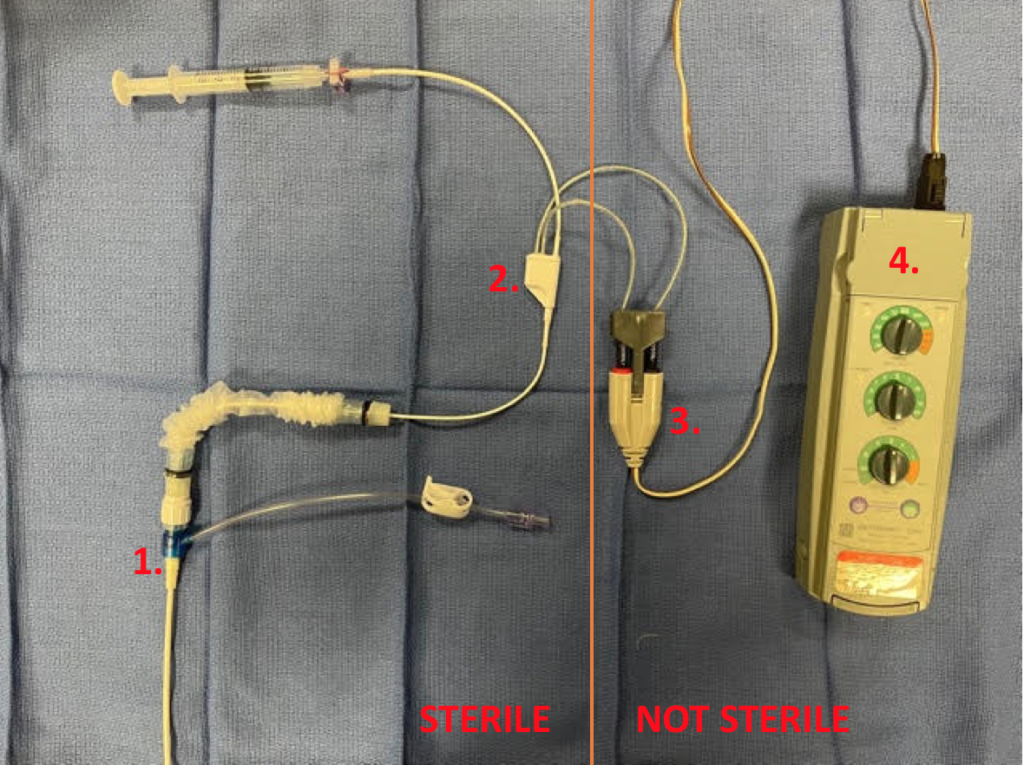
1. 6F Cordis
2. Swan Ganz Pacing Catheter
3. Nonsterile Connecting Cable
4. Pacing Generator
Indications
- Symptomatic sinus bradycardia (after atropine, +/- dopamine/epinephrine, and transcutaneous pacing have failed)
- Mobitz type II second degree AV block
- Complete heart block
- Beta blocker or calcium channel blocker overdose
Preparation
- Patient positioning: supine/Trendelenburg
- 6 French Cordis (“percutaneous sheath introducer kit”)
- Swan Ganz/Bipolar pacing catheter
- Pacer generator (“temporary pacemaker”)
- Nonsterile connecting cable (within pacer generator case in inside sleeve)
- Ultrasound + sterile probe cover
Supplies and room 9 location
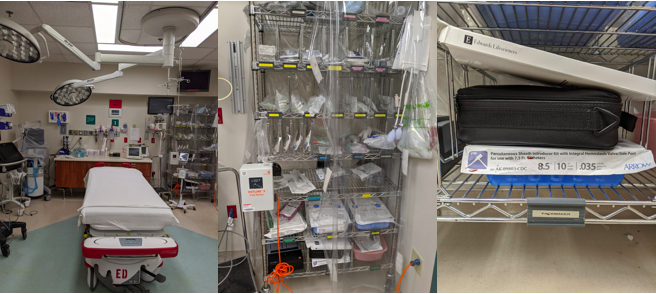
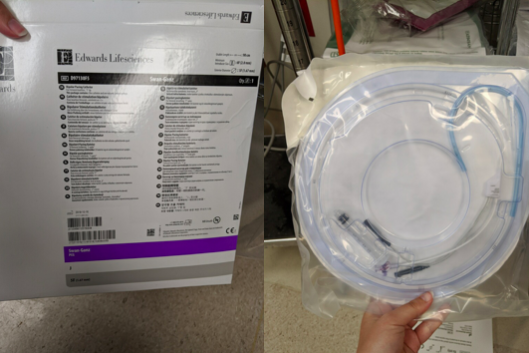

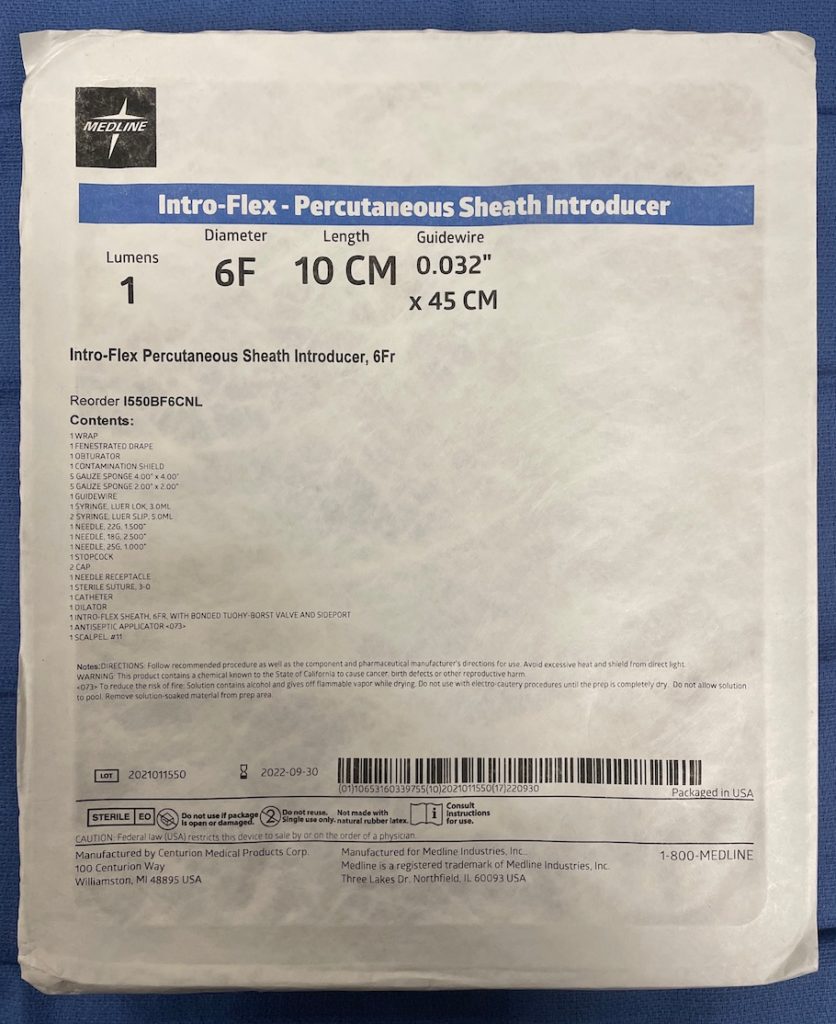
Pacer generator—initial settings
- Turn on
- Rate—80 bpm, rate at which patient will be transvenously paced, at least 20 bpm over the intrinsic rate
- Output—20 mA, electrical output of pacer with every paced beat, decrease until patient has both mechanical (palpating patient’s pulse) and electrical capture
- Sensitivity—3 mV, pacer’s ability to sense intrinsic rate (the lower the sensitivity, the more the pacer will detect intrinsic rate; for example, at 3 mV, the pacer will only detect impulses generated from the heart that are greater than 3 mV)
- Oversensing- Sensitivity is set too LOW so electrical signals are inappropriately recognized as cardiac activity and pacing is inhibited
- Undersensing- Sensitivity is set too HIGH so pacemaker ignores native cardiac activity
Location
- Right internal jugular—preferred
- Left subclavian—use as second option, preferred to leave site available for possible permanent pacer
Steps to placing transvenous pacemaker
- Place cordis
- Set up nonsterile connecting cable (helpful to have assistant connect cable to pacer generator as these are not sterile)
- Ensure proper balloon inflation on Swan Ganz
- Position sterile sleeve over pacer wire and ensure correct orientation
- Insert pacer wire into cords and advance to 20cm (indicated by first two black lines)
- Insert Swan-Ganz + and – pins into nonsterile connecting cable (proximal to positive, distal to negative)
- Have assistant turn on pacer generator with the above settings (remember it is non sterile)
- Inflate balloon and lock purple stopcock (stopcock is on Swan, catheter see below image)
- Advance pacer wire to ~30-35cm (three black lines on pacer wire) while watching monitor for capture (STEMI pattern)
- Troubleshooting:
- if wire coils in RA, pull wire back, twist 180˚ towards patient’s right and re-advance
- if wire fails to capture, can adjust pacer generator settings, consider increasing output and decreasing sensitivity
- Verify capture by either palpating pulse or by pulse ox waveform
- Decrease output until there is no longer capture, then titrate up to the lowest effective output
- Deflate balloon and turn stopcock off
- Expand sterile sleeve
- Suture cordis and place sterile dressing
- Secure pacer wire to patient with tape (can dislodge easily)
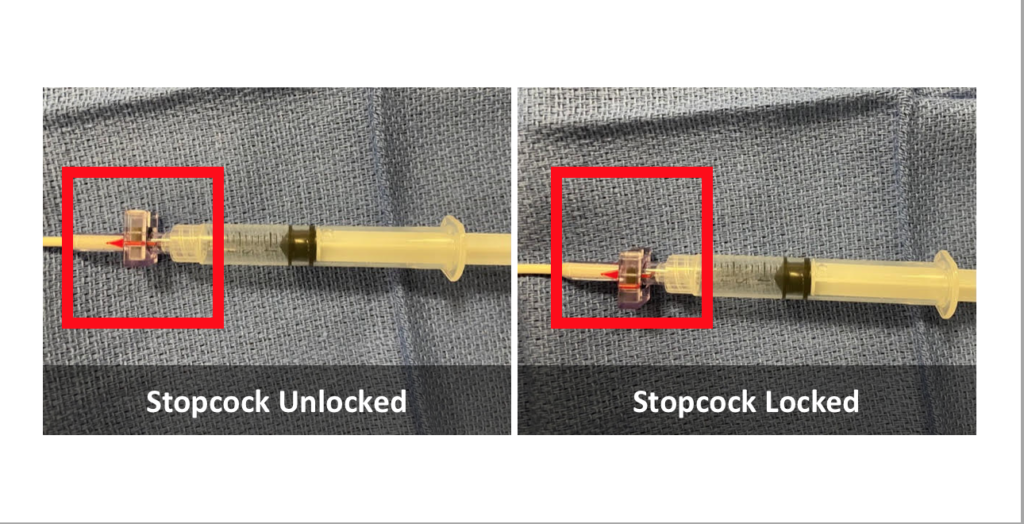
Complications
- Misplacement—can verify with ultrasound or chest x-ray
- Ventricular perforation
- Dysrhythmias
- Pneumothorax
![Room9er ["Room Niner"]:](https://room9er.com/wp-content/uploads/2020/03/cropped-Screen-Shot-2020-03-08-at-3.16.16-PM.png)
hello!,I love your writing very a lot! proportion we communicate more about your article on AOL? I need a specialist in this space to resolve my problem. May be that’s you! Taking a look ahead to peer you.
Hey! I could have sworn I’ve been to this blog before but after checking through some of the post I realized it’s new to me. Nonetheless, I’m definitely glad I found it and I’ll be bookmarking and checking back frequently!
Not only does the glute ham elevate help to strengthen the 2 muscle tissue that work to support your lower again, nevertheless it even engages your lower back itself to extend core energy and bracing
power. To set these up, loop one end of the band around the ankle
hook submit and put the other finish across the higher chest, right underneath
the armpits. The bands supply accommodating resistance, that means more assistance is supplied on the bottom portion of the rep where you’re weakest
and less assist on the high where you’re strongest.
Maybe the commonest mistake associated to glute ham raises an overextension of the lower
back. Trainees would decrease themselves, get back up,
and produce their shoulders method back. The thought is to improve hamstring activation, but doing so only places pressure on the decrease
again. Instead of utilizing a glute ham machine, the variation allows you to do the movement on the ground by anchoring your ft beneath a loaded
barbell.
Secondly, squats tone and add definition to your glutes so you’ve
an aesthetically pleasing and balanced physique.
Thirdly, squats for the glutes enhance posture and assist forestall again pain. Squats supply large versatility to any glute
exercise as a result of they activate so many muscles as a baseline, and
have many variations to promote muscle confusion and
functional strength. For those new to strength training, stability ball leg curls offer
a simpler but effective various. Mendacity in your again along with your toes on a stability ball,
you curl the ball toward your hips, partaking the hamstrings
and glutes whereas stabilizing your core. This low-impact
exercise is ideal for beginners or those recovering from an damage, providing
a gentle introduction to hamstring-focused actions.
There’s a purpose why the top athletes use glute ham developer machines in their training.
Since the glute ham elevate focuses more on the eccentric (lowering) portion of the hamstring, it’s going to help bulletproof your
body in opposition to hamstring strains and even assist stop ACL tears.
Modify the pad of a back extension bench so that it suits in the crease of your hips whenever you mount the
bench. Tuck your pelvis so it’s perpendicular to your backbone, and brace your core.
This specialty piece of fitness center gear can add some considerable power to the posterior chain muscle
tissue, particularly the hamstrings and glutes. The hip thrust is a crucial
glute exercise that activates and strengthens the gluteal
muscular tissues. The hip thrust primarily engages the gluteus maximus, with the secondary engagement of the hamstrings and core muscles to supply stability.
Performing hip thrusts requires you to start by sitting
on the ground along with your upper again supported
towards a bench or sturdy floor. Your toes are planted firmly on the floor, shoulder-width apart, and your knees are bent.
Your brain wants to teach these muscle tissue the way to work collectively in this closed chain movement.
Whether you are trying to enhance your athletic performance or find
a move that locations less strain in your backbone, the glute ham elevate supplies loads of
advantages. Here are 6 advantages that will convince you to add this transfer to your exercise
split. The distinction is that with a nordic curl, your knees
begin at almost the top of the pad, putting an incredible load on the hamstrings.
It is an help exercise that helps construct
muscle conditioning and muscular hypertrophy,
and it does not require loading weights, adding to its advantages even more so.
It may be easily confused with a back extension or a nordic hamstring curl since they’ve an identical setup and look.
If you want to obtain one of the best outcomes attainable whereas
avoiding accidents, it is necessary that you just perform every repetition of the glute ham raise workout slowly with good kind.
While primarily a lower-body exercise, the Glute and Ham Elevate additionally engages the core muscle tissue,
particularly the erector spinae and the rectus abdominis.
This engagement helps improve core stability, crucial for maintaining steadiness during dynamic actions and lowering
the chance of falls. The GHD is also a versatile piece of kit that gives training choices for the core,
glutes, lower back, and other key muscle groups.
These muscle tissue are important for supporting athletic performance and heavy lifts like squats and deadlifts.
By training the hamstrings through each knee
flexion and hip extension, the glute-ham elevate ensures comprehensive improvement of those key muscle teams.
Glute workout routines are actions that concentrate on and strengthen the gluteal
muscles, including the gluteus maximus, gluteus medius, and gluteus minimus.
Glute exercises range from bodyweight workouts similar to squats and lunges to more complicated bodily motions such as hip thrusts and glute bridges.
Adding glute exercises to your exercise routine promotes practical movement patterns and increases overall physique energy,
tones your hips and butt, and reduces the risk
of damage and ache. There are a number of methods
to perform the glute-ham increase or related workout
routines with out the use of a machine. You can perform a
glute-ham increase with a partner help, using a Kaiji
glute-ham strap, using a Barbell Strap, using a lat pulldown seat, or using a barbell
by a power rack.
From the standard body weight Glute-Ham Increase to band-assisted choices and modifications that contain holding
weights, there’s a version suitable for every health level.
When you just move via an exercise with no real thought behind it, you’re only dishonest your self out of muscle activation and
potential positive aspects. I can’t stress this sufficient, guys – Constructing a
mind-to-muscle connection will assist you to perform the train better, ensuring the outcomes you’re on the lookout for.
Push off the ground and attempt to perform a glute-ham increase to return to
the beginning position. Let’s briefly dive into some particular gear
and what you could use it for, plus some alternate options if you’re on a price range.
If rear foot elevated split squats are too tough for you, you can even strive one of
these Bulgarian break up squat alternatives.
Focusing on slow, managed movements ensures most muscle activation and safety.
You can even carry out a wide selection of isometric and superior calisthenics/gymnastic strengthening workout routines on a GHD.
This intensive range of possible makes use of make for
a significant investment and may really improve your coaching.
The GHD is a free-standing piece of equipment that you lay on, with feet hooked in, maintaining the
legs straight and elongating the hamstrings. They allow you to
work via the maximal range of the hamstrings, often with a
stretch on the finish of the motion.
These actually do mar the product, alongside
the design limitations for taller folks. It’s additionally
far too small for taller folks – in case your height is 6ft or greater, you’re going to experience significant problems
as the pad won’t sit in your hip crease optimally. This shifts an extreme quantity of stress down to the thigh and defeats
the purpose of the GHD. Obviously, if this is in your home gym, you don’t really need
to adjust the GHD as soon as you’ve gotten the best length on your hip crease.
The worth remains to be excessive in comparison with another merchandise on this listing – especially for
the size and the decreased stability.
And your hamstrings are critical for pulling/curling your legs toward you.
Now that you have a progression of workout routines to work via, how do you fit them into your current coaching program?
Nicely, for the sake of your poor posterior chain, don’t run off
to the fitness center and try them all of sudden, and
don’t whip out your Powerful Guy headband and bounce to the hardest ones first.
Be sincere with yourself the place you would possibly be strength-wise
and work ahead in a slow yet progressive manner. When doing a glute ham elevate, you should emphasize the reducing portion of every repetition.
References:
Pro Steriods
This is why it’s essential to make changes to your workouts every so often. And on this publish, you’re going to get 10
completely different muscle-building plans and strategies you can start
utilizing. I’m not saying you’ll make progress in every single exercise.
To accomplish that indefinitely can be impossible,
and there’ll be instances when you discover yourself lifting the same amount of weight, for a similar
number of units and reps you probably did before. No matter how
your training week is set up, it’s necessary to train hard and focus on improving your exercise efficiency over time.
In a perfect world, you’ll have a day of relaxation between every
workout.
All the pieces – coaching, food plan, supplementation, restoration, and mindset
– must be in place for bodybuilding success, but with out the coaching, you’ll
by no means end up with a complete image. 3-day splits are higher for bulking as a result of
it might possibly rapidly add mass with a strict exercise and
a correct food plan. One cause why it would not be good for cutting
is as a outcome of in cutting you’re shedding fat, normally by doing cardiovascular workouts.
Sometimes bodybuilders are most likely to exercise
for measurement or power; this workout will assist
both and never only one. This can prove to be advantageous to the superior bodybuilder as it
might possibly help acquire mass or power by taking more day off to
relaxation. Thirdly and eventually, you may be less
more doubtless to be overtraining with a 3-day cut up, while nonetheless getting intense workouts if you do train.
Our app StrengthLog is one hundred pc free to download and use
as a exercise tracker and common energy training app.
You’ll be doing slightly greater reps to complete the exercise off.
Go for three units of 12 reps to essentially fry your hamstrings.
Potentiation acts as a stimulator by increasing rate coding – the quantity and rate at which motor
neurons hearth throughout power coaching. A good approach to potentiate muscles is to steadily lift heavier
weights during the warm up until you’re at your actual weight for the workout – rather than simply a couple of gentle
units. This is a superb change-up from the everyday bodybuilding workout
if that’s what you’ve been doing. It’s actually going to shock your muscle tissue, particularly on those higher physique
days.
They are in a position to do that as a outcome of that is their job and so they have all the
dietary supplements to assist them recover faster, letting them workout longer than the average Joe.
The workout might be split into three totally different body
groups, each designed to allow for enough quantity of rest
and also made to be accomplished in a brief amount of time.
Exercise should take not than 1 hour, but should be a minimum of 45 minutes.
If you have a partner, relaxation when your partner is doing their set and vice versa.
Whether Or Not you’re a seasoned bodybuilder or simply starting out, these are the best practices
for slicing for bodybuilding that can assist you reach your fitness goals.
You get to eat so much, however bulking isn’t any purpose to pig out on junk meals.
You should nonetheless give attention to consuming a variety of complete, nutrient-dense meals to help muscle development and
recovery. Massive overfeeding does little for muscle growth compared to a reasonable caloric surplus.
As A Substitute, it’ll only make you fatter and extend the cutting phase if you want
to see the outcomes of your fitness center sessions.
But that’s not promoted as a lot as new exercise ideas like CrossFit.
These different packages could additionally be are great
for different targets, but not for bodybuilding.
If you wish to get jacked, however can’t ignore those primary
bodybuilding workout routines and ideas that go with it.
The reality is that real bodybuilding workouts have not modified that a lot over
the a long time. Those compound workout routines are what have constructed
great stage-worthy physiques again then and right now.
You May notice some exercises have “Rest Pause”
meaning you’ll perform a rest-pause set in your last set.
To deplete lower body muscle glycogen, experience a stationary bike for ~30 minutes per day after your weight exercises.
You’ll burn up your glycogen shops, and that quantity of standard train won’t cause subcutaneous water retention. From local contests to top-level pro events
like the Arnold Traditional and Mr. Olympia, bodybuilding contests are available for athletes of any degree
and expertise. Many successful competitive bodybuilders like Arnold Schwarzenegger
go on to have careers outside the sport. An article about bodybuilding wouldn’t
be full with no section about anabolic steroids. The
use of performance-enhancing medicine (PEDs) is extremely prevalent in bodybuilding.
Relaxation durations between sets are not written into this
system and we don’t recommend a relaxation interval of a specific period.
If, for a set of 12 to 15 as an example, you do thirteen for one set after which 12
for the subsequent, fine. As lengthy as the form is great and you can’t do another rep
without sacrificing form. Start with poundage you probably can lift with good type for the required rep range.
Eating to build muscle isn’t very totally different after 50, with a couple of
minor issues. Start with one set per exercise, and steadily work your way as much as four units
per workout. You accomplish this by gradually growing how a lot weight you use.
Choose a pair of heavier dumbbells, add a small plate to the bar, or move the pin on the machine to a heavier setting.
The precise exercise is just like the standard bodybuilding exercise.
Once More, you’re simply ending with seven sets on your last train. The typical bodybuilding routine
is dedicating a whole exercise to each muscle. This also often means training every muscle as quickly as every week.
Training your complete physique thrice per week permits you to study the workout routines by performing them frequently while providing you with sufficient time
for relaxation and restoration to develop. 3-day splits
are most likely higher for bulking and sustaining. However an important side
of bulking, slicing or maintaining is one’s food plan. You can have the most effective coaching program on the planet but if
your diet is less than par then you will not make features.
This should be your favorite day as a outcome of this is when you pack on mass from those squats that work
those giant leg muscular tissues and launch development hormone all
through your body. Your base additionally gets stronger and it is possible
for you to to carry more next week! Have a cheat meal the subsequent day as
a reward for going via this punishing and painful week.
Lastly, I’d say some kind of very deep sumo squatting is also really awesome for
the glutes. If you don’t get this message till you’re
50, there’s nonetheless time to be sensible.
Simply comply with the strategies above and you’ll get
again on the winning observe. IT’S MUCH HARDER to construct new muscle tissue than it
is to maintain what you’ve already built, especially as you get older.
If you see a muscular over-50-year-old on the fitness center, it’s a protected guess he or she constructed the lion’s share of their
dimension before they turned forty.
A a lot smarter method is to use your 40s as a transition decade,
the place you begin enjoying a longer, safer sport. Your
strength-centric movements will have heavier loads and
fewer reps. To make this extra clear, they will just have a
set number of reps prescribed, i.e., 4X4 or 3X5 versus 3X8-10.
Any training break up supplies structure, as that’s its complete purpose.
Nevertheless, using a better coaching frequency can make having a specific
aim for the session simpler. On the opposite, with a 5-day break up, you get a lot more time in the fitness center to
essentially target every muscle with loads of work. Thank
you for studying, and I hope you found it informative and useful.
Later within the week, you’re going to carb-load and fill them
back up with glycogen and water.
This is the course that I am following now and it’s working very nicely.
Gaining a “good” amount of muscle mass is good but don’t go overboard.
If you take a look at the image of the man above he’s a bit too massive — gentle and rounded.
Even extra importantly, he does not have great muscle tone.
So after talking with these incredibly sensible scientists on coaching, I then wished to study extra about
the other half of the how to construct muscle equation, vitamin. So it’s comparatively unclear
as to how precisely the good factor about coaching to
failure modifications for larger volume routines.
You should be comfortable swinging these at least to waist height.
If you are at all uncertain or uncertain about your functionality,
drop again to swinging one kettlebell. You can use both the
two-handed swing or the one-hand swing. Extra necessary than which variety you choose is that you focus on making each rep as explosive
as potential.
The loss of testosterone causes hormonal changes that lead to android fats accumulation – meaning belly fats to
you and me. With your decrease testosterone ranges, and lack
of bodily activity, your body quickly begins to alter. Testosterone controls efficiency,
well being, and personality. This is exactly what the thought behind minimalist training is all about – stripping away the cruft
and spending the most effort and energy on no matter provides you essentially
the most benefits. This MVP-exclusive plan is designed that can help
you achieve your core targets. You love the health club
and need to be there extra, however in the present season of your life,
your time is restricted.
This would let you persist with the true 30-minute exercise plan. If you’re naturally skinny and new
to bodybuilding, you probably can go for a larger surplus than somebody who has been lifting weight
for years. You’ll use lots of these extra energy to build lean mass, not physique fat.
Of course, these are simply recommendations, exercise routines successfully used by hundreds if not 1000’s of aspiring bodybuilders.
Nevertheless, you would possibly be free to check out any bodybuilding program that catches your eye or even design your individual.
You can’t go incorrect with barbell rows for constructing a massive, thick back.
If the bench press is the king of exercises for the entrance of
your upper body, the barbell row might be the monarch of the back.
Consuming 30–40 grams of high-quality protein after a workout is a good idea.
You velocity up restoration and kick-start muscle protein synthesis.
A protein shake is a handy choice when you don’t fancy a daily meal immediately after training.
If you’re chopping to lose body fat, your protein necessities increase.
Carbs aren’t essential nutrients and don’t have any direct muscle-building properties.
Nonetheless, they’re your main gas throughout high-intensity train like weight
training. Experienced bodybuilders use advanced training strategies to interrupt via plateaus and enhance their exercise intensity.
Compound workouts like the squat, rows, and presses take a lot out of
you.
If you’re new, scroll down and choose one of the other splits
under. If you wish to crush PRs, add slabs of muscle, or lose weight, KIZEN has the proper program for you.
If you’ve ever dreamed of turning heads along with your physique, Mass
Influence is your blueprint to making it occur.
Not only do you get related results by lifting average weights for extra reps, but you might additionally cut
back your risk of harm. Power training is a very protected exercise,
but going all-out heavy puts extra strain in your physique than utilizing average hundreds.
With a full body exercise plan, you realize precisely what you’re doing that day…everything!
Every muscle group must be fatigued when you’re carried out with a full-body routine.
They’re even shorter should you maximize productivity and cut back
your rest instances. One of the vital thing regulators of muscle mass, energy, virility,
and stamina throughout your late teenagers and twenties is testosterone.
It can also be an ideal program for somebody doing another exercise on the side, be it
cycling, climbing, MMA or no matter.
You will use a mixture of accelerating load and reps in your
hypertrophy movements. Apart from the strength movements,
you will see movements with a rep range, i.e. 3X8-10 or 3X10-12; these are your
muscle hypertrophy movements. On the opposite hand, as
you may see below, using 5 days enables you to develop more specific targets for each coaching
session. This may be very effective for hitting prescribed
benchmarks. This means you’ve the time to train for
more specific goals and hit specific muscle tissue.
Have the program custom-made to your private wants with considered one of
our professional… A leg workout could make
you retain fluid under your pores and skin for a variety of days.
References:
oral steroids list (Laurene)